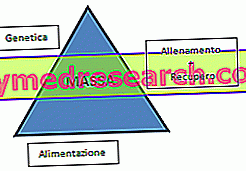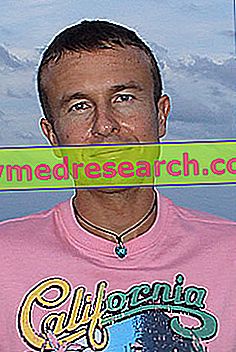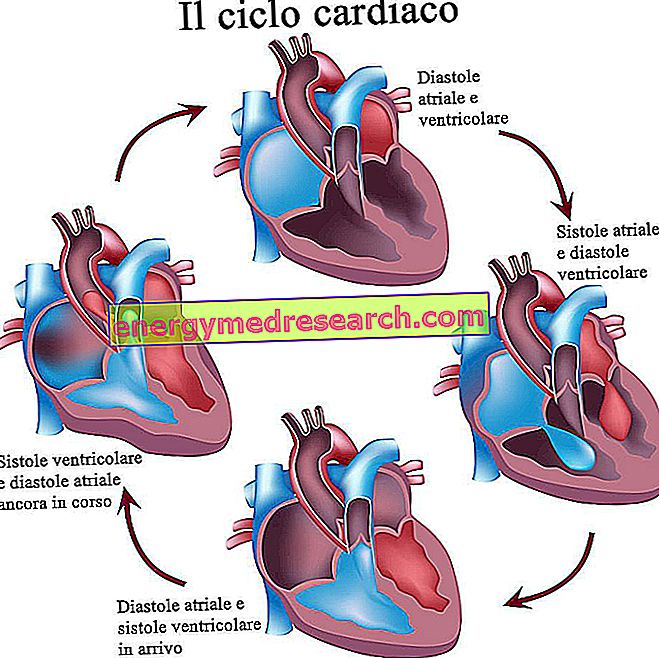The diet to increase muscle mass is a diet that, if associated with a specific training, should favor the increase of body mass and especially of the compartment concerning the fat-free or Free-Fat-Mass (FFM) mass, better known as "lean mass".
Warning! The following article does NOT presume to dictate any principle or discredit other methods, therefore it exclusively represents MY professional (and personal) vision of the topic in question.
Genetics, training, rest and diet

According to some technicians (generally sportsmen and not Body-Builders) the element that allows the increase of muscle tissue is mainly genetic, which includes some very specific physiological limits; for others, the specific training and the variability of the stimulus are the first discriminating factors to consider and disregard (within certain limits) the individual predisposition and in part the diet, while a last category places the "right diet for the mass ".
In my opinion, muscle mass could be represented graphically by an equilateral triangle with 3 sides:
- GENETICS
- TRAINING + RECOVERY
- SUPPLY
NB . If the program to increase the mass of an "X" subject is deficient in one of the three elements, the intervention of the sports technician must focus more on it, even when this would mean relying on another professional figure.
Taking for granted the development of a specific training (and a registry age that excludes puberty as a major development phase), the increase in muscle mass in the athlete (and especially in the BBs) could be analyzed in three historical moments of training: at the 6th month - after a year - after 3 years, at the end of which most of the subjects reach almost the apex of muscular genetic expression. Many readers might consider this statement extremely reductive and / or limiting, and I admit myself that accepting it can be demotivating; on the other hand, a realistic approach and an empirical vision of training are absolutely fundamental requisites to avoid a future disillusionment or bad interpretation of the progress achieved by the subject.
In a time frame of about 3 years, in which the training must be intense, continuous and worthily supported with a good diet for the mass, the organism arrives to express most of its potential; in a nutshell, growing from the point of view of mass and strength is hard work and requires a lot of dedication and perseverance, but the progression of the results depends exclusively on the methodological correctness in the organization of training and diet for mass.
It is quite well known that mass training should consist mainly of High Volume Training (HVT) and respective high TUT (Time Under Tension), taking care to also include periods of strength through High Intensity Training (HIT) in order not to slow down the progressive increase in the load (understood as "kg of cast iron raised"). On the other hand, on the other hand, from the food point of view, if they hear (the word is given to me) "of cooked and raw"!
Ultimately, how is the diet structured for mass?
Importance of the diet
In general, the diet for the mass is an aspect that interests mainly the athletes or Body-Builders (BBs) already formed, or those subjects who (for seniority of training) have already enjoyed the first physiological adaptations thanks to training; this means that, INITIALLY, nutrition is often considered a negligible "detail" or even an aspect relevant only to the achievement of high objectives such as sports competitions. MISTAKEN! It is logical that the muscular tissue undergoes an evident initial process of hypertrophy regardless of the diet ... but it is also true that with or without the right diet for the mass the body responds differently to anabolic-hypertrophic stimuli.
The diet for the mass must have some essential requirements that I will report below.
- Healthiness and nutritional balance: the diet for the mass CANNOT and MUST NOT subject the body to any kind of stress
- Energy and nutritional intake equal to or greater than the normal calorie diet
- Multi fractionated energy distribution
General characteristics
NB . The diet for the mass must favor the increase of muscle mass, guarantee the body hydration and keep the glycogen and creatine-phosphate reserves intact, leaving the adipose tissue unchanged.
Healthiness and nutritional balance
the diet for the mass must NOT harm those who follow it, this means that its composition, in addition to being ALWAYS harmless, should aim at both sustaining energy expenditure and covering nutritional and plastic needs of an athlete or BB.
Suitability of energy and nutritional intake
the energy supply of the diet for the mass should be AT LEAST of a normocaloric nature, that is to supply enough energy and nutrients to guarantee the maintenance of the desirable physiological weight and body composition; if this were not enough, it is possible to increase the total contributions based on the needs of the subject.
With regard to energy macronutrients, we could decide to increase the amount of carbohydrates (with anti-catabolic function before training or pro-anabolic at the end of training) and possibly lipid, both uniformly distributed throughout the day; the same is true for the proteinic one (to favor the reconstruction of myofibrils and predispose them to hypertrophy) which is also uniformly distributed and estimated on the basis of weight and real body composition.
In the mass diet, the TOTAL amount of energy must also take into account training / training and, if the subject does not adequately respond to treatment, it is possible to increase it up to 110% of normocaloric (high calorie diet).
In general, the supply of essential nutrients, vitamins and mineral salts is easily reachable both with a normocaloric-type mass diet and with a high-calorie diet.
Multi fractionated energy distribution
the energy and nutritional distribution of the diet for the mass must be multi-fractionated, in order to guarantee a TOTAL coverage of the nutrients avoiding opening windows of catabolism during the day (at least 6 meals). This principle is applied differently if it is: a normocaloric diet or a high-calorie diet; the quantitative prevalence of an energetic nutrient (glucides, lipids and proteins) on the other two must respect the TIME and the type of activity carried out, therefore it acquires a considerable importance on the success of the diet for the mass. In the first case (normocaloric) the distribution of nutrients during the day can be fairly fair between carbohydrates, lipids and proteins, since the energy introduced is well calibrated based on the overall energy expenditure and nullifying the possibility that the anabolic stimulation of the insulin on the fat deposit is excessive. On the contrary, if it is a hypercaloric mass diet, the distribution of energy nutrients must respect the hormonal balance as much as possible, concentrating the carbohydrates especially in previous, intra- and post-workout meals, avoiding large glycemic loads especially in the evening hours or in any case during periods of inactivity.
Carbohydrates
Details on dietary carbohydrates for mass
The sugars in the diet for the mass must guarantee an energy supply sufficient to avoid catabolism, to stimulate the insulin for muscle anabolism and to support the reconstruction of energy reserves (BETTER if in association with proteins and less with lipids). They must be predominantly low glycemic index (GI) in meals far from training and high GI immediately after the session.
Grassi
Details on lipids in the diet for mass
The fats in the diet for the mass have the function of covering the needs of essential lipids (AGE) and of liposoluble vitamins (A, D, E, K); they should not increase proportionally to the energy and if they remain around 25% they would limit the increase of adipose tissue even if associated with good carbohydrate weights.
Protein
Protein details in the diet for mass
Proteins in the diet for mass should be calculated on the subject's muscle mass; I personally use a coefficient in relation to the desirable physiological weight (therefore overall but which includes at most 15% of adipose tissue) of the sportsman, adapting it to his real body composition. The proteins must be evenly distributed over the days but not exceed 30-40g per meal, in order to guarantee their absorption and the plastic / energy use by the body.
NB . For a practical example, read an Example of diet for mass.



